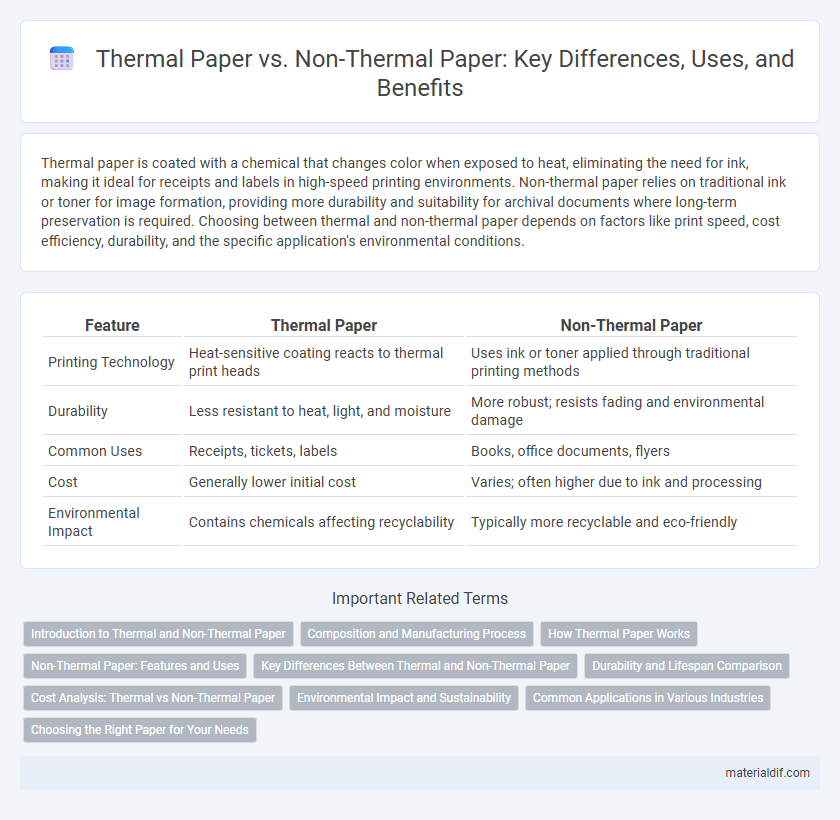Thermal paper is coated with a chemical that changes color when exposed to heat, eliminating the need for ink, making it ideal for receipts and labels in high-speed printing environments. Non-thermal paper relies on traditional ink or toner for image formation, providing more durability and suitability for archival documents where long-term preservation is required. Choosing between thermal and non-thermal paper depends on factors like print speed, cost efficiency, durability, and the specific application's environmental conditions.
Table of Comparison
| Feature | Thermal Paper | Non-Thermal Paper |
|---|---|---|
| Printing Technology | Heat-sensitive coating reacts to thermal print heads | Uses ink or toner applied through traditional printing methods |
| Durability | Less resistant to heat, light, and moisture | More robust; resists fading and environmental damage |
| Common Uses | Receipts, tickets, labels | Books, office documents, flyers |
| Cost | Generally lower initial cost | Varies; often higher due to ink and processing |
| Environmental Impact | Contains chemicals affecting recyclability | Typically more recyclable and eco-friendly |
Introduction to Thermal and Non-Thermal Paper
Thermal paper is specially coated with chemicals that change color when exposed to heat, enabling quick, ink-free printing commonly used in receipts and labels. Non-thermal paper requires traditional ink or toner and is utilized for documents demanding durability and long-term legibility. Understanding the structural and functional differences between thermal and non-thermal paper guides optimal selection for printing applications.
Composition and Manufacturing Process
Thermal paper is coated with a heat-sensitive layer containing dye and developer chemicals that react to heat during printing, whereas non-thermal paper relies on traditional ink or toner applied via inkjet or laser printers. The manufacturing process of thermal paper involves applying a uniform thermal coating onto the base paper using precision coating techniques, while non-thermal paper production follows standard papermaking methods without additional chemical layers. This fundamental difference in composition and processing determines the suitability of each paper type for specific printing technologies and applications.
How Thermal Paper Works
Thermal paper contains a special heat-sensitive coating that reacts to heat by changing color, eliminating the need for ink or toner. When passing through a thermal printer, the heated print head selectively activates the coating, producing clear and sharp images or text instantly. This chemical reaction enables fast, quiet, and efficient printing, commonly used in receipts, labels, and tickets.
Non-Thermal Paper: Features and Uses
Non-thermal paper is distinguished by its compatibility with traditional ink-based printers like laser and inkjet systems, offering high durability and resistance to heat and moisture. Commonly used for receipts, labels, and tickets requiring longevity without fading, non-thermal paper supports various finishes, including matte and gloss, enhancing print clarity and readability. Its versatility in printing methods and robust physical properties make non-thermal paper ideal for archival documents, shipping labels, and industrial applications where long-term preservation is critical.
Key Differences Between Thermal and Non-Thermal Paper
Thermal paper is coated with a chemical that changes color when exposed to heat, enabling fast and quiet printing without ink or toner. Non-thermal paper requires traditional printing methods, such as inkjet or laser, which use ink, toner, or ribbons to produce images. Thermal paper is sensitive to heat and light, leading to shorter durability, whereas non-thermal paper offers better longevity and resistance to environmental factors.
Durability and Lifespan Comparison
Thermal paper, coated with heat-sensitive chemicals, offers a shorter lifespan and reduced durability due to its susceptibility to heat, light, and friction, which can cause fading or image loss over time. Non-thermal paper, typically uncoated or treated for enhanced durability, maintains image integrity for extended periods, making it preferable for archival purposes and long-term document retention. Factors such as environmental exposure and usage conditions significantly impact the longevity and reliability of printed materials on both thermal and non-thermal paper types.
Cost Analysis: Thermal vs Non-Thermal Paper
Thermal paper generally costs more upfront than non-thermal paper due to its specialized heat-sensitive coating, but it can reduce expenses over time by eliminating the need for ink and ribbons. Non-thermal paper often requires additional supplies such as ink cartridges or toner, increasing ongoing operational costs despite its lower initial price. Evaluating total cost of ownership, including maintenance and consumables, reveals that thermal paper can be more cost-effective for high-volume printing environments.
Environmental Impact and Sustainability
Thermal paper contains chemical coatings like BPA or BPS, which pose significant environmental and health risks due to their non-recyclability and potential to contaminate recycling streams. Non-thermal paper, often made from recycled fibers and free from chemical coatings, offers a more sustainable alternative with greater recyclability and lower ecological footprint. Choosing non-thermal paper supports waste reduction and safer disposal practices, enhancing overall environmental sustainability.
Common Applications in Various Industries
Thermal paper is widely used in retail point-of-sale receipts, banking transaction slips, and shipping labels due to its fast, heat-sensitive printing capabilities requiring no ink. Non-thermal paper, favored in book printing, office documents, and artistic applications, relies on traditional ink or toner for durability and archival quality. Industries such as logistics, hospitality, and healthcare utilize thermal paper for rapid data capture, while education and publishing sectors predominantly use non-thermal paper for high-resolution, permanent records.
Choosing the Right Paper for Your Needs
Selecting the right paper type hinges on your specific printing requirements and environmental conditions. Thermal paper reacts to heat for fast, high-quality image production, ideal for receipts and labels, while non-thermal paper relies on traditional ink, offering durability and compatibility with various printers. Consider factors such as print longevity, cost-effectiveness, and exposure to heat or light when deciding between thermal and non-thermal paper for optimal performance.
Thermal Paper vs Non-Thermal Paper Infographic

 materialdif.com
materialdif.com